In this Issue
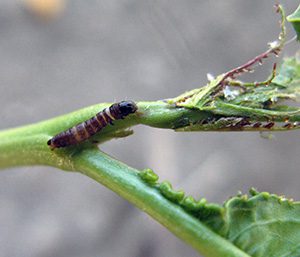 Codling moth: updated spray dates table
Codling moth: updated spray dates table- Woolly apple aphid: treat if present
- Peach twig borer: treatment time coming up
- Western cherry fruit fly: treatment starts when fruits turn salmon blush color
- Backyard Orchard Irrigation
WHAT TO WATCH FOR
- Inspect old pruning cuts of apple trees for the cottony woolly apple aphid.
- Examine leaves of apple and cherry, and fruit of peach/nectarine, for powdery mildew lesions. Apply a fungicide where necessary to prevent additional spread.
- Thin apples when they are 1/2-inch in diameter, and thin peaches now, or in the next few weeks (earlier is better). On apples, thin clusters to one apple and to six inches apart. Thin peaches to 4 to 6 inches apart.
APPLE, PEAR
Codling Moth
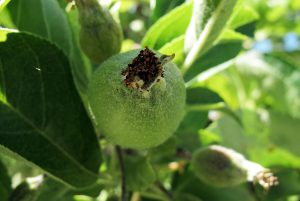
View a pdf of the spray timing table. Be sure to read the instructions at the top of the page, for how to read the table.
Soon, codling moths in most sites will be in the “period of greatest egg hatch.” What this means is that 75% of all eggs for the first generation will be hatching over a 2 to 3 week period. So if you applied a treatment for the start of egg hatch, be sure to re-apply once or twice during the date range shown on the table.
Also during that time period, take some time to inspect your fruit for any codling moth activity. Typically, with the smaller-sized fruit, larvae will enter through the calyx (blossom) end, so you may not be able to tell that there is a “worm” in the apple until it starts pushing out frass (sawdust-like excrement).
Treatment
Woolly Apple Aphid
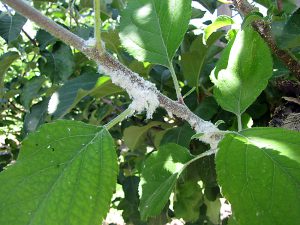
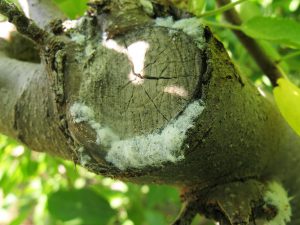
Woolly apple aphids are just starting to show up in the warmer areas of the Wasatch Front. They are first seen where they overwinter in the trees, which is primarily around old pruning cuts. They also overwinter on roots, and some of these stay on roots year-round, while others will migrate up the bark.
Woolly apple aphids are different from typical aphid species in that they feed on twigs, bark and roots, and have a cottony covering on their bodies. We usually do not see these aphids in the trees until mid to late spring.
It is important to scout your own trees to determine when and if a treatment is needed. Start by looking for aphids around the callus wounds of old pruning scars or wounds, and on root suckers.
Treatment
If woollies are a problem every year, it is best to treat them early. Otherwise, treat them when they increase to the point of covering more than 10-20% of the tree.
Because of the aphid’s thick, waxy coating, it is important to spray the tree to drip to reach the aphid bodies.
- Backyard growers can use insecticidal soap+1% oil, aimed directly at the colonies, or Ortho Fruit, Flower, and Vegetable (containing acetamiprid).
- Options for commercial growers: click here.
PEACH/NECTARINE, APRICOT, PLUM
Peach Twig Borer
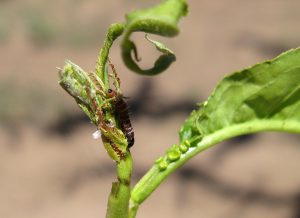
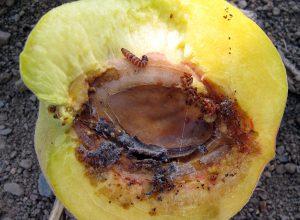
View a pdf of the spray timing table. Be sure to read the instructions at the top of the page, for how to read the table.
Peach twig borer is the “worm in the peach”. It is a somewhat sporadic pest in Utah, where some locations have a low enough population that trees do not need to be treated.
Peach twig borer larvae prefer to bore into succulent twigs. Later in the season, when twigs become hardened off and unpalatable, larvae feed inside the fruit.
If peach twig borer is sporadic, you can get away with a single (or no) application for each generation (up to 2 well-timed sprays). Otherwise, one spray is required for first generation, and multiple sprays may be required for second generation (when the fruit is susceptible).
Treatment Options – Backyard Growers
Conventional:
- Ortho Flower, Fruit, and Veg. (acetamiprid): Lasts 14 days; softer on beneficial insects
- Sevin, Bonide Fruit Tree Spray (carbaryl): Lasts 14 days
- Spectracide Triazicide (gamma-cyhalothrin): Lasts 14 days
Organic:
- Green Light, Gardens Alive Bull’s Eye, Monterey (spinosad): Lasts 7 days
- Ortho Fruit Spray/Fertilome Fruit Tree Spray (pyrethrin): Lasts 5 days
- Safer BioNEEM (azadirachtin): Lasts 7 to 10 days
Treatment Options – Commercial
- Commercial growers, click here.
CHERRY
Western Cherry Fruit Fly
In the May 12 post, we provided treatment options, and noted that you should start protecting fruit when they turn a salmon blush color. Be mindful of the fruit color in the sunniest locations of the tree, as those will turn color first.
USU Entomologist Dr. Diane Alston has reported that cherry fruit fly adults have been trapped at the experimental farm in Kaysville. The flies are active now, but again, are not capable of laying eggs in green fruit.
Treatment Options – Backyard Growers
Conventional:
- Malathion (malathion): every 7 days
- Ortho Flower, Fruit, and Veg. (acetamiprid): every 14 days
- Sevin, Bonide Fruit Tree Spray (carbaryl): every 14 days
- Spectracide Triazicide (gamma-cyhalothrin): every 14 days
Organic:
- Green Light, Gardens Alive Bull’s Eye, Monterey (spinosad): every 7 days
- Ortho Fruit Spray/Fertilome Fruit Tree Spray (pyrethrin): every 5 days
- Safer BioNEEM (azadirachtin): every 7 to 10 days
Treatment Options – Commercial
Dr. Alston has conducted research trials on various treatments for cherry fruit fly, including a newer material, Exirel. This product (cyantraniliprole) showed excellent control of cherry fruit fly, and was more effective than its relative, Altacor. It has slight, localized systemic activity, and is able to kill maggots inside the fruit.
The label says it may cause fruit markings. Dr. Alston found no fruit marking on tart cherry, and we are not aware of markings to sweet cherry in Utah.
For other options, click here.
PRODUCTION INFORMATION – BACKYARD ORCHARD IRRIGATION
Dr. Teryl Roper, Pomology Professor at USU, provides the following information for proper irrigation.
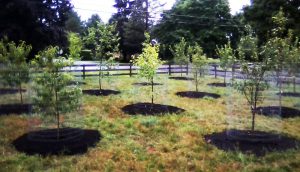
The cool and wet spring of 2017 has provided ample soil moisture for turfgrass and trees alike. As the end of May approaches, and with it warmer, drier weather, it is time to begin irrigation. Fruit trees, like all plants, need adequate water to produce both vegetative growth and fruit. Trees that don’t receive adequate water will generally have fewer and smaller fruit.
Fruit trees should have a vegetation-free zone around their trunks. Keep grass, weeds, and other vegetation at least three feet away. This allows the trees to access water and nutrients in this zone without competing with other plants. Cover this area with mulch to help prevent weeds and grass from growing near the trunks.
Irrigation needs for fruit trees vary with tree age, soil type, and time of year.
Newly planted fruit trees:
- After planting, build a shallow reservoir around each plant that will hold water.
- Apply 2-4 gallons of water a couple of times per week during the first few of months after transplanting
- Allow the soil to slightly dry at the surface between waterings.
Young established trees (2-4 years old) and established bearing trees:
- These benefit from less frequent, but deep irrigations (see next paragraph).
- Lawn sprinklers will wet the soil to a depth of only six to 12 inches, but tree roots are often much deeper.
- Water drains more readily through sandy soils than silt or clay soils, thus sandy soils will require more frequent irrigation.
Deep irrigation can be accomplished by using a soaker hose placed in a circle just inside the dripline of the tree. Turn the water on just a trickle and allow the soaker hose to run for several hours. A regular lawn sprinkler could also be run on a low setting for a couple of hours to allow the water to penetrate deeply into the soil. This also allows water to get below the rooting zone of turfgrasses. During the hottest months of summer, a mature fruit tree can transpire 50 gallons of water per day. This water needs to be replenished to the soil regularly.
In the late summer and fall, continue to irrigate fruit trees. This is particularly important for trees such as cherries, apricots, and peaches whose fruit has already been harvested and may be neglected after harvest. Subjecting trees to water stress in preparation for winter is not a good practice. Trees will do best acclimating for winter if the soil is moist in the fall.
